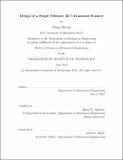| dc.contributor.advisor | Brian W. Anthony. | en_US |
| dc.contributor.author | Zhang, Xiang, Ph. D. Massachusetts Institute of Technology | en_US |
| dc.contributor.other | Massachusetts Institute of Technology. Department of Mechanical Engineering. | en_US |
| dc.date.accessioned | 2015-12-16T15:54:42Z | |
| dc.date.available | 2015-12-16T15:54:42Z | |
| dc.date.copyright | 2015 | en_US |
| dc.date.issued | 2015 | en_US |
| dc.identifier.uri | http://hdl.handle.net/1721.1/100306 | |
| dc.description | Thesis: S.M., Massachusetts Institute of Technology, Department of Mechanical Engineering, 2015. | en_US |
| dc.description | This electronic version was submitted by the student author. The certified thesis is available in the Institute Archives and Special Collections. | en_US |
| dc.description | Cataloged from student-submitted PDF version of thesis. | en_US |
| dc.description | Includes bibliographical references (pages 90-92). | en_US |
| dc.description.abstract | Over the past decade, substantial effort has been directed toward developing ultrasonic systems for medical imaging. With advances in computational power, previously theorized scanning methods such as ultrasound tomography can now be realized. This thesis presents the design, error analysis, and initial image reconstructions from a single element 3D ultrasound tomography system. The system enables volumetric pulse echo or transmission imaging of distal limbs, for applications including: improving prosthetic fittings, monitoring bone density, and characterizing muscle health. The system is designed as a flexible mechanical platform for iterative development of algorithms targeting imaging of soft tissue with bone. The mechanical system independently controls movement of two single element ultrasound transducers in a cylindrical water tank. Each transducer can independently circle about the center of the tank as well as move vertically in depth. High resolution positioning feedback (~1[mu]m) and control enables flexible positioning of the transmitter and the receiver around the cylindrical tank; exchangeable transducers enable algorithm testing with varying transducer frequencies and beam geometries. High speed data acquisition (DAQ) through a dedicated National Instrument PXI setup streams digitized data directly to the host PC. System positioning error has been quantified and is within limits for the desired imaging modality. Imaging of various objects including: calibration objects, phantoms, bone, animal tissue, and human forearm are presented accordingly. | en_US |
| dc.description.statementofresponsibility | by Xiang Zhang. | en_US |
| dc.format.extent | 92 pages | en_US |
| dc.language.iso | eng | en_US |
| dc.publisher | Massachusetts Institute of Technology | en_US |
| dc.rights | M.I.T. theses are protected by copyright. They may be viewed from this source for any purpose, but reproduction or distribution in any format is prohibited without written permission. See provided URL for inquiries about permission. | en_US |
| dc.rights.uri | http://dspace.mit.edu/handle/1721.1/7582 | en_US |
| dc.subject | Mechanical Engineering. | en_US |
| dc.title | Design of a single element 3D ultrasound scanner | en_US |
| dc.title.alternative | Design of a single element three-D ultrasound scanner | en_US |
| dc.title.alternative | Design of a single element three-dimensional ultrasound scanner | en_US |
| dc.type | Thesis | en_US |
| dc.description.degree | S.M. | en_US |
| dc.contributor.department | Massachusetts Institute of Technology. Department of Mechanical Engineering | en_US |
| dc.identifier.oclc | 931029423 | en_US |
